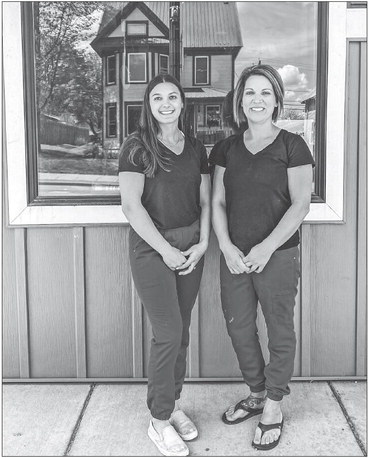Marathon


COMMUNITY LIVING
Send Marathon news to: RR@tpprinting.com phone: 715-223-2342 fax: 715-223-3505 P.O. Box 677 103 West Spruce Street Abbotsford, WI 54405 Rib Falls HCE
The Rib Falls HCE met April 20 at the home of Arlyn Heise. Refreshments and desserts were served. Connie Hamann was the guest speaker and she spoke on the different scams. Worksheets were handed out, with various members winning prizes.
The roll call was: did you have a nickname from years ago? The secretary and treasurer reports were read and approved. Pennies for Friendship was collected.
Craft Learning Day was a sucess, it was said.
HCE County Day is set for Thursday, June 2, at Good Shepherd Lutheran Church, Wausau. A brat sale will be Friday and Saturday at Festival Foods, Wausau.
Mittens are needed for the Head Start. Members should bring a canned goods item for the Circle of Joy. The club’s next meeting will be May 11 at the home of Gloria Kreager. The meeting ended with Creed II. The birthday song was sung to one of the members as she opened her gift from her secret pal. Games were played with all receiving prizes.
Covid dashboard
Marathon Public Schools reports as of May 16 there are three people among 850 staff and students with COVID-19. The school has had 183 cases of coronavirus during the 2021-22 school year.
Fall musical
Marathon High School will perform a fall musical, “Beauty and the Beast.” Au- ditions for the show will be held Wednesday, May 25, from 3:30p.m. to 7 p.m. in the Marathon High School auditorium. For more information, contact Cally O’Leary at coleary@marathon.k12.wi.us.
St. Mary’s calendar
St. Mary’s School will have a DARE graduation on Thursday, May 26, 12 p.m. to 2:30 p.m. at the Marathon Sports Center.
The school will hold a graduation ceremony for eighth graders on Wednesday, June 1, at 6:30 p.m.
Solo and ensembles
Marathon music students performed at the state solo and ensemble festival on Saturday, May 7, held at UWStevens Point. The students were Emma DeBroux, Grace Riesgraf, Carlotta Galiano, Halle Laabs, Grace Barnet, McKinnley Marks, Owen Marks and Gwen Bergman. Riesgraf was selected out of the state qualifiers as an exemplary soloist.
St. Matthew’s
Registration is open for St. Matthew’s Vacation Bible School to be held Monday, July 18, through Friday, July 22, with daily classes 9 a.m. to 11 a.m. The school is for children ages three and one-half through seventh grade.
Story Time
Bring your family to a series of special outdoor story times at the Marathon City Branch Public Library.
Children of all ages and their parents or guardians are encouraged to attend these 30-minute programs consisting of stories, songs and other literature-based activities. These story times will take place the first and third Thursday of the month, May through September, from 10:20 to 11 a.m. This month’s story time will be on May 19. Bring your blankets or chairs, bug spray, shaded stroller, sunblock, water and anything else you need for your family to be outdoors for a fun half hour!
No registration required and these story times will not be rescheduled if the weather doesn’t cooperate. Call the Marathon City Branch for up-to-date information at 715-443-2775.
Basketball camps
A girls skills basketball camp will be held Monday through Wednesday, June 13-15, in the old Marathon High School gymnasium. The camp for first, second and third grade girl basketball players will be held 11:30 a.m. to 12:30 p.m.; 12:30 p.m. to 2 p.m. for girls in grades four and five; and 1 p.m. to 3:30 p.m. for girls in grades six and seven. Sign-up deadline is May 20.
All girls will receive skill instruction in dribbling, shooting and finishing along with prizes and a t-shirt. Registration forms are available on the district website and sent home with girls from school. For more information, contact Jeff Schneider at 715-432-8158.
Spirituality Center
St. Anthony’s Spirituality Center will host a retreat Friday through Sunday, May 20-22, entitled “Celebrating Franciscan Women.” The presenters will be Sr. Jolynn Brehm, FSPA Sr. Marla Lang, FSPA; Lee Ann Niebuhr, OFS; and Adele DiNatalie, Affl. FSPA.
The retreat will focus on St/Clare, St. Elizabeth of Hungary, Margaret of Cortona and Thea Bowman, FSPA.
Guests are expected to wear a mask or cloth face covering in common areas except at mealtimes.
To register, call 715-443-2236 or email info@sarcenter.com.
Hall of Fame
The Marathon Red Raider Hall of Fame committee is accepting nominations for the 2022 Hall of Fame class.
Past nominees not yet selected do not need to be nominated again and are eligible in succeeding years.
Nominations will be accepted until Wednesday, June 15. Recipients will be notified by Friday, July 15. A 2022 Hall of Fame induction ceremony will be the Sunday following the Marathon Athletic Club golf outing.
River float
The Marathon Lions Club will sponsor an inner tube, kayak or canoe float on the Big Rib River on Sunday, June 12, from Rib Falls to the Rib River Ballroom to support Marathon City park restoration.

New Marathon businessEmily Balsis will open Utopia Day Spa, 511 Main Street, Marathon City, on June 1 offering massage therapy services, infrared sauna and foot detoxification. The therapist on staff will be Jamey Cree. The business already operates out a single location in Medford.

